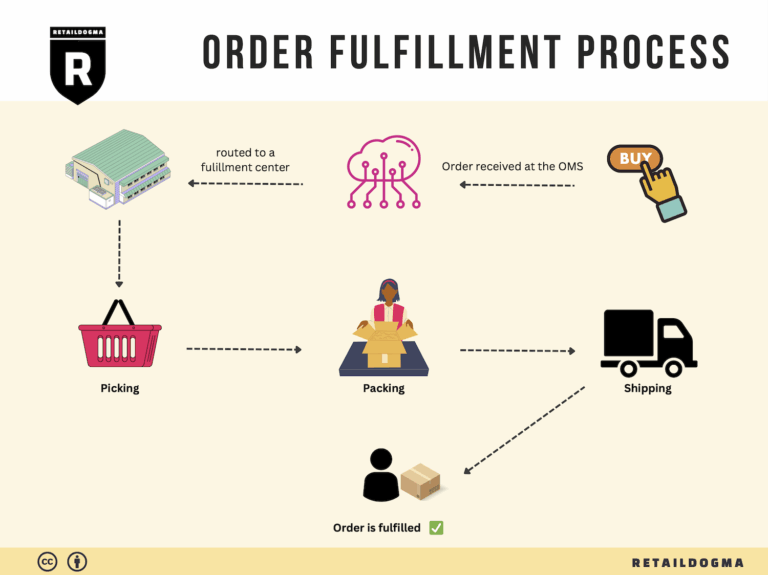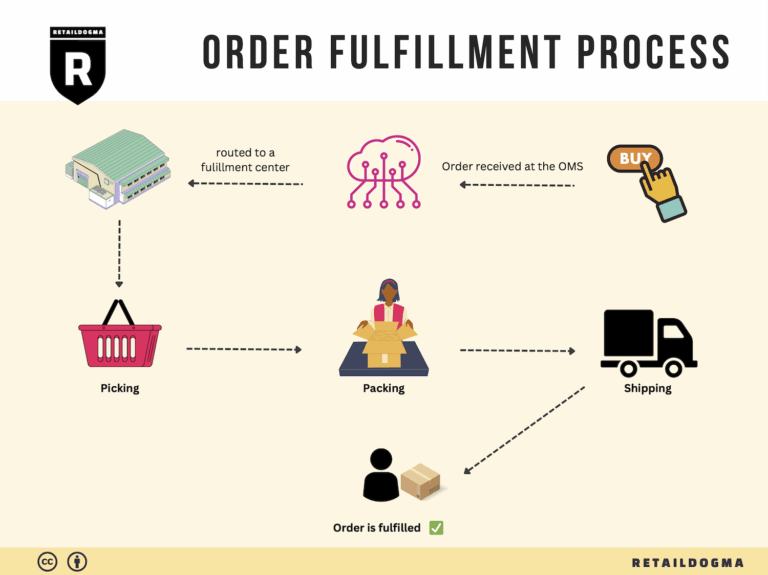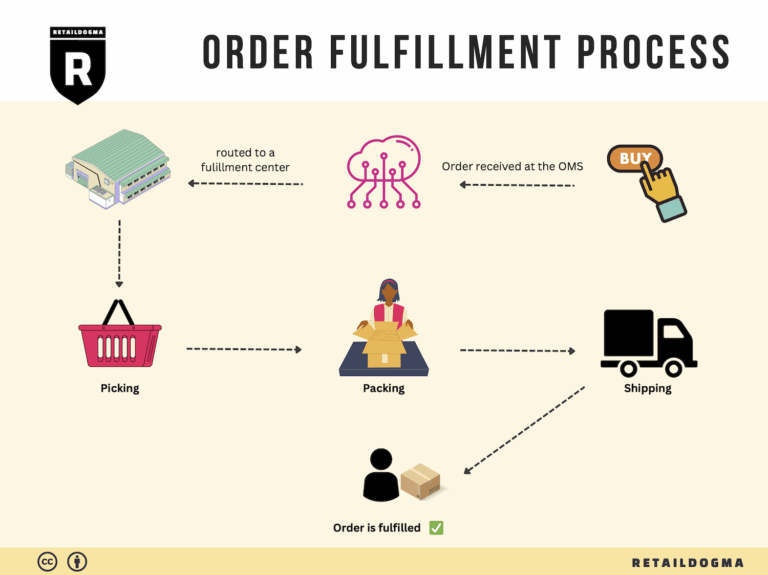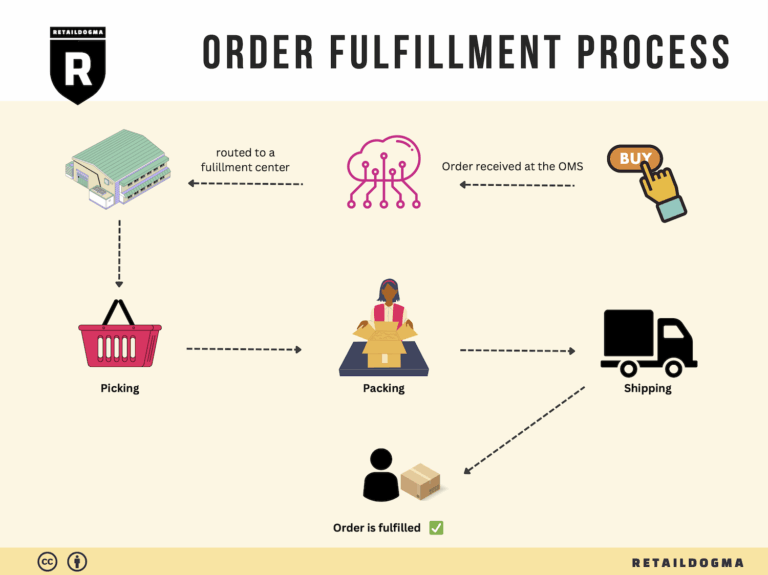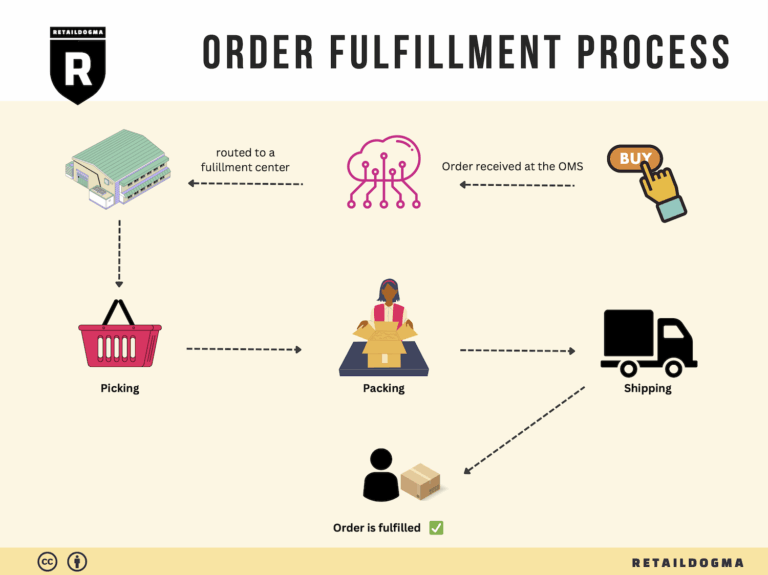How Order Fulfillment Works: A Step-by-Step Guide for Businesses
What is E-commerce Fulfillment? An Introduction for Growing Businesses
Getting overwhelmed with packing and shipping orders is a common hurdle for growing e-commerce businesses. As sales increase, so does the complexity of fulfilling those orders efficiently and accurately. Many entrepreneurs find themselves bogged down by logistics, diverting their focus from scaling their business to managing the day-to-day operations of packing and shipping. This is where e-commerce fulfillment comes into play.
Understanding E-commerce Fulfillment
At its core, fulfillment is the comprehensive process of getting a product from your warehouse to your customer’s doorstep. It encompasses everything from inventory management and order processing to packaging and shipping. For businesses looking to grow, mastering this process is crucial for maintaining customer satisfaction and operational efficiency.
What This Guide Will Cover
This guide aims to demystify e-commerce fulfillment by exploring various models available to business owners. We will delve into popular options such as Third-Party Logistics (3PL) and Fulfillment by Amazon (FBA), examining the pros and cons of each. Understanding these models will enable you to make informed decisions about which fulfillment method aligns best with your business goals.
Additionally, we will outline the core services typically offered by fulfillment partners, including:
- Warehousing: Safe and efficient storage solutions for your products.
- Order Processing: Streamlining the steps from receiving an order to shipping it out.
- Shipping and Delivery: Choosing the best carriers and methods for timely delivery.
- Returns Management: Handling returns efficiently to maintain customer satisfaction.
Choosing the right fulfillment partner is a critical step for scaling your business. This guide will provide practical tips on what to look for in a partner, including reliability, technology integration, and customer service capabilities. Furthermore, we will discuss pricing structures and how to evaluate the cost-effectiveness of different fulfillment options.
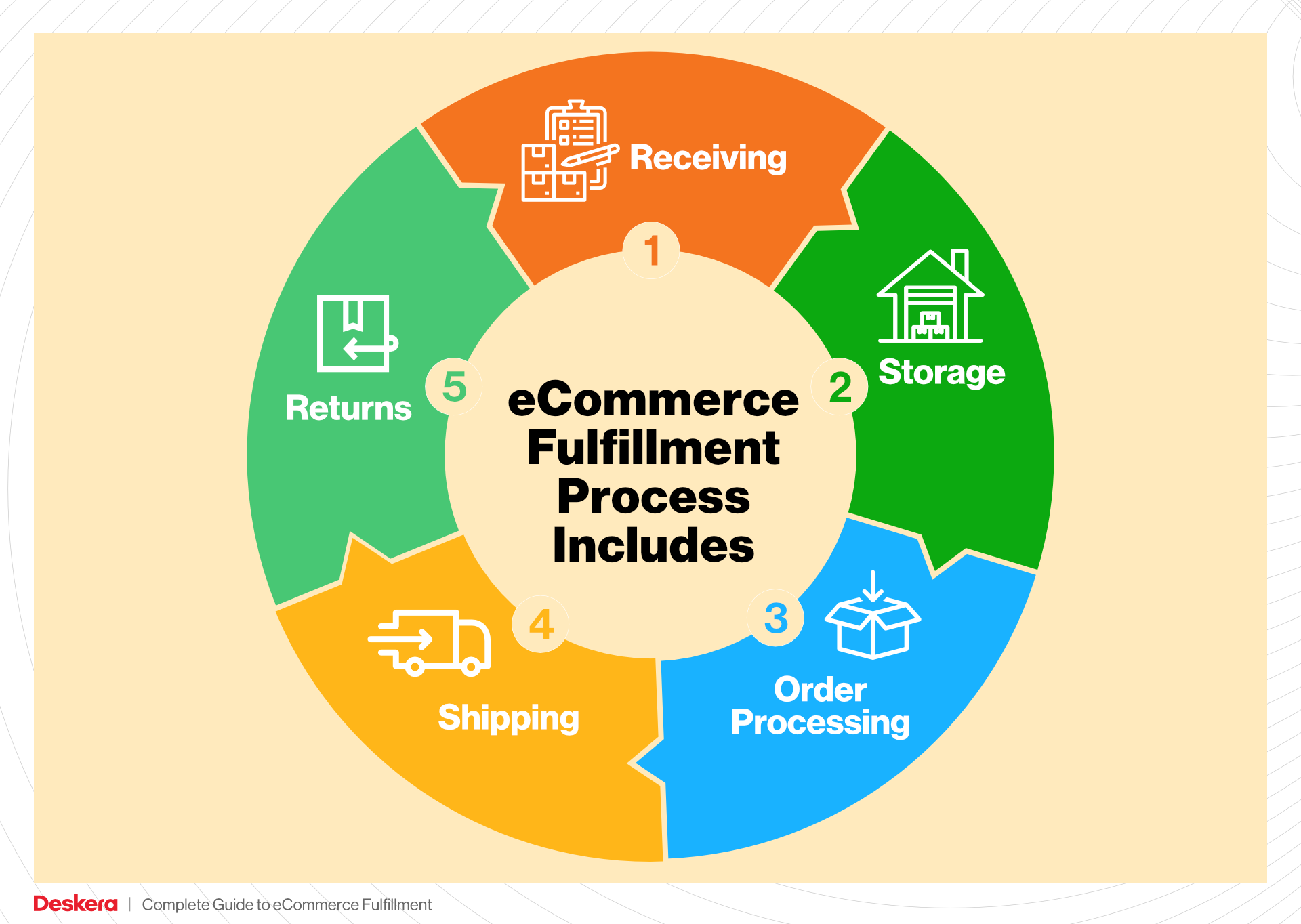
Empowering Smart Decisions
The ultimate goal of this guide is to empower e-commerce businesses to make informed, strategic decisions regarding their logistics. By understanding the intricacies of fulfillment, you can streamline your operations, enhance customer satisfaction, and ultimately drive growth. As you navigate the complexities of e-commerce fulfillment, remember that the right logistics partner can be a game-changer for your business.
What You’ll Learn In This Guide
- What is E-commerce Fulfillment? An Introduction for Growing Businesses
- The Order Fulfillment Process: From ‘Buy’ Button to Customer’s Door
- Comparing Fulfillment Models: In-House vs. 3PL vs. Dropshipping
- A Deep Dive into Amazon FBA: Pros, Cons, and Who It’s For
- Core Services Offered by Fulfillment Centers
- How to Choose a Fulfillment Partner: A 6-Point Checklist
- Understanding Fulfillment Pricing: A Breakdown of Common Fees
- Frequently Asked Questions (FAQs) about Fulfillment
- Conclusion: Is Outsourcing Fulfillment the Right Move for Your Business?
- Important Disclaimer
The Order Fulfillment Process: From ‘Buy’ Button to Customer’s Door
1. Receiving Inventory
The first step in the order fulfillment process is receiving inventory. This involves accepting shipments of products from suppliers and verifying that the quantity and quality match the purchase order. Upon arrival, items are checked against the shipping documents to confirm that the correct products have been delivered. This process typically includes the use of Stock Keeping Units (SKUs) to track each product.
Importance: Accurate receiving is crucial because any discrepancies can lead to stockouts or overstock situations, which can negatively impact sales and customer satisfaction. Additionally, it sets the foundation for efficient inventory management.
Key Term: SKU (Stock Keeping Unit) – A unique identifier for each product that helps in tracking inventory levels and managing stock efficiently.
2. Warehouse Storage
Once inventory is received and verified, the next step is warehouse storage. Products are organized and stored in designated areas within the warehouse according to their categories, sizes, or sales velocity. Efficient warehousing strategies often employ techniques such as zone picking, where items are grouped based on their storage locations, and FIFO (First In, First Out) to ensure older stock is sold first.
Importance: Proper storage ensures that items are easily accessible for picking, which speeds up the order fulfillment process. An organized warehouse minimizes the time spent searching for products, thus improving overall efficiency.
Key Term: FIFO (First In, First Out) – An inventory management method that ensures the oldest stock is sold first, reducing the risk of obsolescence or spoilage.
3. Order Picking
Order picking is the process of selecting items from the warehouse to fulfill customer orders. This step usually begins once a customer places an order through the e-commerce platform. Staff or automated systems generate pick lists, which are detailed instructions outlining the specific items and quantities to retrieve.
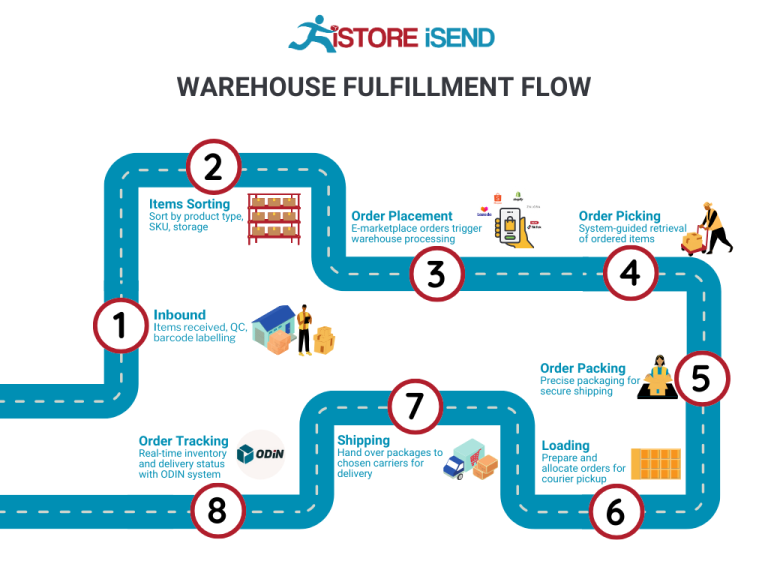
Importance: Efficient picking is vital for meeting customer expectations regarding delivery times. The quicker and more accurately items are picked, the higher the customer satisfaction. Errors during this stage can lead to incorrect shipments, resulting in returns and diminished trust in the brand.
Key Term: Pick List – A document or digital record that outlines the items to be picked from the warehouse, including their locations and quantities.
4. Order Packing
After items are picked, they move to the order packing stage. Here, products are carefully packaged according to predefined guidelines, which may include considerations for branding, product safety, and shipping requirements. Businesses often use automated packing systems to streamline this process, ensuring consistent quality and efficiency.
Importance: Effective packing protects products during transit and enhances the unboxing experience for customers. Packaging also plays a critical role in branding and can influence repeat purchases by leaving a positive impression.
Key Term: Packing Slip – A document included with the shipment that lists the contents of the package, serving as a confirmation for the customer and a checklist for warehouse staff.
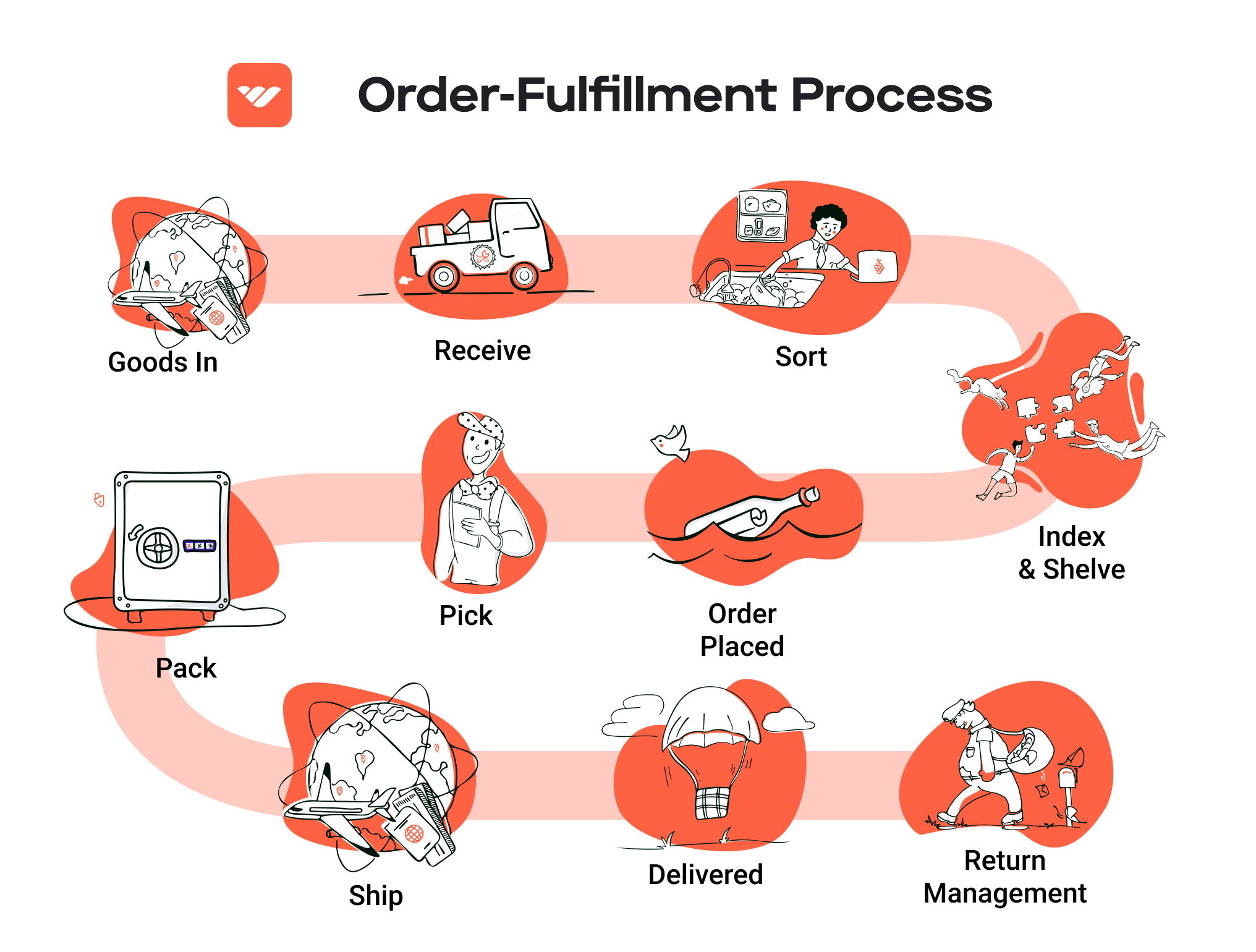
5. Shipping & Delivery
The final step in the order fulfillment process is shipping and delivery. Once orders are packed, they are handed over to logistics partners for transportation to the customer’s address. This phase involves choosing the right shipping method based on factors such as cost, speed, and destination. Businesses may offer various shipping options, including standard, expedited, and international shipping.
Importance: Timely and reliable delivery is crucial for maintaining customer satisfaction and loyalty. Customers expect their orders to arrive on time and in good condition. Efficient shipping practices can significantly reduce costs and improve service levels.
Key Term: Last Mile Delivery – The final step of the delivery process where the package is transported from a distribution center to the customer’s doorstep, often considered the most critical and complex phase of logistics.
By understanding and optimizing each of these five steps in the order fulfillment process, e-commerce businesses can enhance their operational efficiency, reduce costs, and improve customer satisfaction, ultimately driving growth and scalability in a competitive market.
Comparing Fulfillment Models: In-House vs. 3PL vs. Dropshipping
Fulfillment Model Comparison
| Model | Who Handles Inventory | Best For (Business Stage) | Key Advantage | Key Disadvantage |
|---|---|---|---|---|
| In-House Fulfillment | The e-commerce business itself | Established businesses with stable sales | Complete control over inventory and processes | High operational costs and resource allocation |
| Third-Party Logistics (3PL) | A specialized logistics provider | Growing businesses needing scalability | Cost-effective, scalable, and expertise in logistics | Less control over fulfillment and potential for errors |
| Dropshipping | Suppliers or manufacturers | Startups and small businesses | Low startup costs and no inventory risk | Lower profit margins and dependency on suppliers |
In-House Fulfillment
In-house fulfillment involves managing the entire logistics process within the e-commerce business itself. This includes inventory management, warehousing, order processing, packing, shipping, and returns handling. Companies that adopt this model often have their own warehouse facilities and staff dedicated to fulfillment tasks. The primary advantage of in-house fulfillment is the high level of control it provides over inventory and order processing. Businesses can customize the fulfillment process to meet their specific needs, ensuring that branding and customer service standards are upheld.
However, the in-house model comes with significant drawbacks, particularly in terms of operational costs. Maintaining a warehouse requires substantial investment in facilities, technology, and labor. Additionally, businesses must manage fluctuations in demand, which can lead to overstocking or stockouts. As a company scales, the complexities of in-house fulfillment can hinder growth, especially during peak seasons when the volume of orders surges. Therefore, while this model may suit established businesses with stable sales, it may not be the best option for those looking to rapidly expand or enter new markets.
Third-Party Logistics (3PL)
Third-party logistics (3PL) providers specialize in managing logistics functions for e-commerce businesses. They offer services such as warehousing, order fulfillment, shipping, and returns management. This model is particularly beneficial for growing businesses that require scalability without the burden of managing logistics in-house. By partnering with a 3PL, companies can leverage the provider’s expertise in logistics, technology, and infrastructure, allowing them to focus on core business activities like marketing and product development.
One of the key advantages of using a 3PL is cost-effectiveness. Businesses can save on warehouse costs, technology investments, and labor, as they only pay for the services they utilize. Moreover, 3PLs often have established relationships with carriers, which can lead to better shipping rates and faster delivery times. However, the primary disadvantage is the potential loss of control over the fulfillment process. Miscommunications or errors in order processing can negatively impact customer satisfaction. Additionally, businesses may face challenges in integrating their systems with those of the 3PL, which could lead to delays and discrepancies. Despite these challenges, 3PLs are an excellent option for businesses seeking to scale efficiently and effectively.
Dropshipping
Dropshipping is a fulfillment model where the retailer does not keep products in stock. Instead, when a customer places an order, the retailer purchases the item from a third-party supplier, who then ships it directly to the customer. This model is particularly appealing for startups and small businesses due to its low barrier to entry. Entrepreneurs can launch an e-commerce store without the financial burden of holding inventory, making it an attractive option for those testing new product ideas or entering niche markets.
The primary advantage of dropshipping is the minimal upfront investment required. Retailers do not need to invest in warehousing or inventory, reducing financial risk. Additionally, dropshipping allows for a wide product selection, as retailers can offer a variety of items without the need to stock them. However, the model also has notable disadvantages. Profit margins tend to be lower compared to other fulfillment methods, as suppliers typically charge a premium for their services. Furthermore, retailers are dependent on their suppliers for inventory management, shipping, and product quality, which can lead to issues such as stockouts or shipping delays. Consequently, while dropshipping is an excellent entry point for new businesses, it may not be sustainable for long-term growth without careful supplier management and strategic planning.
Conclusion
In summary, the choice of fulfillment model significantly impacts an e-commerce business’s operational efficiency and customer satisfaction. In-house fulfillment offers control but comes with high costs; 3PLs provide scalability and expertise but may reduce control; and dropshipping minimizes financial risk but can lead to lower margins and dependence on suppliers. Businesses should evaluate their specific needs, growth aspirations, and resource availability when selecting the most suitable fulfillment strategy.
A Deep Dive into Amazon FBA: Pros, Cons, and Who It’s For
Understanding Fulfillment by Amazon (FBA)
Fulfillment by Amazon (FBA) is a logistics service that allows e-commerce sellers to store their products in Amazon’s fulfillment centers. Amazon then takes care of storage, packaging, shipping, and customer service for these products. When a customer places an order, Amazon picks, packs, and ships the product on behalf of the seller. This service is particularly beneficial for businesses looking to scale their operations without having to manage logistics in-house.
How FBA Works
- Product Listing: Sellers list their products on Amazon and choose to enroll in FBA.
- Inventory Shipment: Sellers send their inventory to Amazon’s fulfillment centers. Amazon provides guidelines on how to package and label the products.
- Storage: Amazon stores the products in its warehouses until an order is placed.
- Order Fulfillment: When a customer orders a product, Amazon handles the picking, packing, and shipping processes.
- Customer Service: Amazon also manages customer service and returns for these orders, providing a seamless experience for both sellers and buyers.
This model allows sellers to leverage Amazon’s extensive logistics network, reaching millions of customers efficiently.
Pros of Amazon FBA
1. Prime Eligibility
One of the most significant advantages of using FBA is that products become eligible for Amazon Prime. This status not only boosts visibility but also attracts a large customer base that prioritizes quick shipping and convenience. Prime members are known for their higher purchasing frequency, which can significantly increase sales for sellers.
2. Customer Trust
Amazon is a trusted brand, and by using FBA, sellers can leverage this trust. Customers often feel more comfortable purchasing from sellers whose products are fulfilled by Amazon, as they associate FBA with reliability, quality service, and hassle-free returns.
3. Multi-Channel Fulfillment
FBA isn’t limited to sales on Amazon. Sellers can use Amazon’s fulfillment services to manage orders from their own websites or other e-commerce platforms. This capability allows businesses to centralize their inventory management and logistics, providing a streamlined solution for fulfilling orders across multiple channels.
4. Simplified Logistics
FBA simplifies the logistics process for sellers. Amazon handles storage, shipping, returns, and customer service, allowing sellers to focus on other aspects of their business, such as marketing and product development.
5. Scalability
FBA provides a scalable solution for growing businesses. As sales increase, sellers can easily send more inventory to Amazon without needing to invest in additional warehouse space or logistics staff. This flexibility is crucial for businesses experiencing seasonal peaks or rapid growth.
Cons of Amazon FBA
1. High Fees
While FBA provides numerous benefits, it comes at a cost. Amazon charges various fees, including storage fees (monthly and long-term) and fulfillment fees per unit sold. These costs can add up quickly, particularly for sellers with low-margin products.
2. Strict Inventory Rules
Amazon has strict guidelines regarding inventory management. Sellers must adhere to specific labeling, packaging, and shipping standards. Failure to comply can result in penalties, additional fees, or even suspension of the seller account. This level of scrutiny can be daunting for small businesses unfamiliar with the requirements.
3. Commingling Risks
FBA operates on a commingled inventory model, meaning that your products may be stored alongside those of other sellers. This can lead to potential issues, such as receiving returns of items that are not yours or facing difficulties in tracking your inventory accurately. Sellers must weigh the risks of commingling against the convenience of using FBA.
4. Limited Control Over Shipping
When using FBA, sellers relinquish control over the shipping process. While Amazon is known for its efficiency, any issues with shipping or fulfillment can negatively impact the seller’s reputation. If Amazon fails to meet customer expectations, the seller may face negative reviews or account health issues.
5. Dependency on Amazon
By relying on FBA, sellers become dependent on Amazon’s platform and policies. Changes in Amazon’s rules, fee structures, or algorithms can significantly impact a seller’s business. This dependency can be risky for those looking to build a sustainable, independent brand.
Who is FBA Best For?
Fulfillment by Amazon is particularly well-suited for:
- Small to Medium-Sized Businesses: Businesses that lack the resources to manage their logistics and fulfillment can benefit from the efficiency and scalability of FBA.
- Brands Seeking Rapid Growth: Companies looking to expand quickly and reach a broader audience can leverage Amazon’s infrastructure to scale without significant upfront investment in logistics.
- Entrepreneurs with Limited Logistics Experience: New sellers or entrepreneurs who are unfamiliar with warehousing and fulfillment can rely on FBA’s expertise to manage these complexities.
- Businesses with Seasonal Products: Companies that experience seasonal spikes in demand can use FBA to handle increased order volume without the need for long-term warehousing solutions.
- Sellers Focused on Customer Experience: Brands that prioritize customer satisfaction can benefit from Amazon’s trusted fulfillment services, ensuring a reliable and efficient purchasing experience for their customers.
In conclusion, Fulfillment by Amazon offers a robust solution for e-commerce businesses looking to streamline their logistics and reach a wider audience. However, it is essential to weigh the pros and cons carefully to determine if FBA aligns with your business model and growth objectives.
Core Services Offered by Fulfillment Centers
Inventory Management & Warehousing
Inventory management and warehousing form the backbone of an efficient fulfillment operation. Fulfillment centers provide dedicated storage space for products, enabling e-commerce businesses to store their inventory in a centralized location. This service includes tracking inventory levels, managing stock replenishment, and maintaining optimal storage conditions.
Benefits:
-
Space Optimization: By utilizing a fulfillment center, e-commerce businesses can free up valuable warehouse space and avoid the costs associated with leasing or maintaining their own facilities. Fulfillment centers often employ advanced storage solutions to maximize space efficiency.
-
Real-Time Inventory Tracking: Most fulfillment centers offer sophisticated inventory management systems that provide real-time visibility into stock levels. This capability helps businesses avoid stockouts or overstock situations, allowing for better demand forecasting and inventory control.
-
Improved Cash Flow: Storing products in a fulfillment center allows businesses to convert their inventory into cash more quickly. With efficient order processing and fulfillment, companies can reduce the time products spend in storage, thereby improving cash flow.
-
Specialized Storage Conditions: Many fulfillment centers are equipped to handle specific product requirements, such as temperature control for perishable items or secure storage for high-value goods. This ensures that products are stored in optimal conditions, maintaining their quality and compliance with regulations.
Pick and Pack Services
Pick and pack services are integral to the order fulfillment process. This service involves selecting items from inventory based on incoming orders (picking) and preparing them for shipment (packing). Fulfillment centers typically automate much of this process, leading to faster and more accurate order processing.
Benefits:
-
Speed and Efficiency: Automation and streamlined processes in fulfillment centers significantly enhance the speed of order processing. Orders can be picked and packed within hours, ensuring timely delivery and improving customer satisfaction.
-
Accuracy: Fulfillment centers employ technology to reduce human error during the picking and packing process. With systems that confirm the right items are selected and packed, businesses can trust that their customers receive exactly what they ordered.
-
Custom Packing Solutions: Many fulfillment centers offer tailored packing services, allowing businesses to brand their packaging or include promotional materials. This personalization can enhance the customer experience and encourage repeat purchases.
-
Scalability: As e-commerce businesses grow, their order volumes can fluctuate. Fulfillment centers can easily scale their pick and pack services to meet increased demand during peak seasons, ensuring that businesses can maintain service levels without investing in additional infrastructure.
Kitting and Assembly
Kitting and assembly services involve combining individual items into pre-defined sets or kits, which are then packaged together for shipping. This service is particularly beneficial for businesses that sell products that are often purchased together or require assembly before use.
Benefits:
-
Enhanced Customer Offering: By offering kits or bundled products, businesses can create unique offerings that appeal to customers. This strategy can increase average order value and improve customer satisfaction by simplifying the purchasing process.
-
Streamlined Operations: Kitting and assembly reduce the complexity of the fulfillment process by preparing products in advance. This minimizes handling times during order fulfillment, allowing for faster processing and shipping.
-
Inventory Management: Kitting can simplify inventory management by allowing businesses to track bundled products as single SKUs. This reduces the complexity of inventory tracking and can lead to more efficient stock replenishment.
-
Cost Savings: By outsourcing kitting and assembly to a fulfillment center, businesses can avoid the costs associated with managing these processes in-house. This can lead to overall cost savings and allow businesses to focus on their core operations.
Returns Management (Reverse Logistics)
Returns management, or reverse logistics, is a critical service offered by fulfillment centers. This process involves handling customer returns efficiently and effectively, ensuring that returned products are processed, restocked, or disposed of according to the business’s guidelines.
Benefits:
-
Customer Satisfaction: A smooth returns process can significantly enhance customer experience. Fulfillment centers that manage returns efficiently allow businesses to maintain positive relationships with customers, encouraging repeat purchases.
-
Cost Efficiency: By outsourcing returns management, businesses can reduce the operational burden and costs associated with handling returns in-house. Fulfillment centers often have established processes to manage returns quickly and efficiently.
-
Inventory Recovery: Fulfillment centers can assess returned products, determining whether they can be restocked or need refurbishment. This capability maximizes the recovery of inventory value and minimizes losses associated with returns.
-
Data Insights: Managing returns through a fulfillment center provides valuable data insights into customer behavior and product performance. Analyzing return reasons can help businesses refine their product offerings and improve overall sales strategies.
In conclusion, partnering with a fulfillment center offers e-commerce businesses a comprehensive suite of services that streamline operations, enhance customer satisfaction, and enable scalability. By leveraging these core services, businesses can focus on growth while ensuring that their logistics are handled efficiently and effectively.
How to Choose a Fulfillment Partner: A 6-Point Checklist
Location & Warehouse Network
The geographical positioning of your fulfillment partner’s warehouses is crucial for effective logistics and timely deliveries. A partner with a well-distributed network can reduce shipping times and costs, especially if your business serves multiple regions or countries.
Questions to Ask:
– Where are your warehouses located, and how does this affect shipping times to my key markets?
– Do you have the capability for cross-border shipping, and what are the associated costs?
– How do you handle inventory distribution across your warehouse network?
Understanding the location dynamics will help you ensure that your fulfillment partner can meet your customers’ expectations regarding delivery speed and reliability.
Technology & Integrations
In today’s digital age, the technology used by your fulfillment partner can significantly impact your operational efficiency. A robust technology stack allows for seamless order processing, inventory management, and real-time tracking. Additionally, compatibility with your existing systems (like e-commerce platforms and accounting software) can streamline operations and reduce manual errors.
Questions to Ask:
– What fulfillment management software do you use, and how does it integrate with my e-commerce platform?
– Can you provide real-time inventory tracking and reporting?
– What automation capabilities do you offer to reduce manual intervention in order processing?
A strong technological foundation ensures that your fulfillment operations can scale efficiently and adapt to changing market demands.
Specializations (e.g., cold storage, oversized items)
Depending on your product offerings, you may require specific fulfillment capabilities. Some fulfillment partners specialize in handling certain types of products, such as temperature-sensitive items or oversized goods. Ensuring that your partner has the necessary expertise and facilities is vital for maintaining product integrity.
Questions to Ask:
– Do you have specialized facilities for handling my product type (e.g., cold storage for perishable goods)?
– What protocols do you have in place for managing sensitive or high-value items?
– Can you accommodate unique packaging or shipping requirements for oversized items?
Choosing a partner with the right specializations can prevent costly errors and ensure that your products are handled appropriately.
Scalability & Capacity
As your business grows, your fulfillment needs will evolve. A partner that can scale with you is essential to avoid disruptions in service and to accommodate fluctuating order volumes. Understanding your partner’s capacity to handle peak seasons, such as holidays or sales events, is also important for maintaining customer satisfaction.
Questions to Ask:
– What is your current capacity for handling orders, and how does this change during peak seasons?
– How do you manage inventory fluctuations, and what support do you offer during busy times?
– Can you provide case studies or examples of how you’ve scaled operations for other clients?
A partner with proven scalability will allow you to focus on growth without worrying about fulfillment bottlenecks.
Pricing and Contracts
Transparent pricing models and flexible contracts are vital for maintaining a healthy bottom line. Understanding the costs associated with different services, including storage, pick and pack, and shipping, will help you budget effectively. Additionally, look for contract terms that provide flexibility as your needs change.
Questions to Ask:
– Can you provide a detailed breakdown of your pricing structure, including any hidden fees?
– What are the terms of your contracts, and how flexible are they in the event of changing business needs?
– Are there options for volume discounts or long-term contracts that can benefit my business?
A clear understanding of pricing will help you assess whether the partnership is financially viable and sustainable in the long term.
Customer Support & Reviews
The quality of customer support can significantly impact your experience with a fulfillment partner. Responsive and knowledgeable support can help resolve issues quickly and maintain smooth operations. Additionally, researching customer reviews and testimonials can provide insight into the partner’s reliability and service quality.
Questions to Ask:
– What level of customer support do you provide, and how can I reach you if issues arise?
– Do you offer dedicated account management, and what does that entail?
– Can you provide references or testimonials from other clients in my industry?
Investing time in evaluating customer support will ensure that you have a reliable partner who can assist you when challenges arise.
Conclusion
Selecting the right fulfillment partner is a critical decision that can significantly influence your e-commerce business’s success. By using this checklist, you can systematically evaluate potential partners and ensure they align with your operational needs and growth objectives. Take the time to conduct thorough due diligence, and don’t hesitate to ask probing questions to find the best fit for your business.
Understanding Fulfillment Pricing: A Breakdown of Common Fees
Initial Setup Fees
Initial setup fees are one-time charges that cover the costs associated with onboarding your business to a fulfillment provider’s system. These fees can vary significantly based on the complexity of your operations and the services required. Typically, initial setup may include:
- Account Configuration: Establishing your account in the provider’s system, which may involve integrating your e-commerce platform with their logistics software.
- Inventory Setup: Inputting your product details, including SKUs, dimensions, and weights into the system.
- Training: Some providers offer training sessions to help you and your team understand how to use their platform effectively.
Initial setup fees can range from a few hundred to several thousand dollars, depending on the provider and the extent of customization needed. To get an accurate quote, it’s essential to discuss your specific requirements with the fulfillment provider.
Receiving Fees
Receiving fees are incurred when your inventory arrives at the fulfillment center. This fee covers the labor and resources needed to unload, inspect, and store your products. Common factors influencing receiving fees include:
- Volume of Inventory: Larger shipments may attract different pricing structures; some providers offer tiered pricing based on the total volume received.
- Inspection Requirements: If you require detailed inspections of your products upon arrival, additional charges may apply.
- Special Handling: Products that require special handling due to size, weight, or fragility may incur higher receiving fees.
Typically, receiving fees are calculated per pallet or per box, with prices varying based on the fulfillment center’s location and the nature of your inventory.
Storage Fees (per pallet/bin)
Storage fees are charged for the space your inventory occupies within the fulfillment center. These fees are often calculated on a monthly basis and can vary based on:
- Storage Type: Different fees apply for pallets versus smaller bins. Pallet storage is generally more cost-effective for bulk items.
- Duration: Fees may be pro-rated based on the length of time your inventory is stored. Some providers have minimum storage fees, which can be crucial for businesses with seasonal inventory.
- Special Conditions: If your products require specific storage conditions (e.g., temperature-controlled environments), this can impact your storage fees.
Understanding your product turnover rate is essential, as prolonged storage can lead to increased costs. Many fulfillment providers offer volume discounts for businesses storing larger quantities of inventory.
Pick & Pack Fees (per item/order)
Pick and pack fees are charged for the labor involved in retrieving items from storage and packaging them for shipment. These fees can vary based on:
- Number of Items: Most providers charge a base fee for picking an order, plus an additional fee for each item picked. For example, a provider might charge a flat rate for the first item and a reduced rate for each subsequent item.
- Complexity of Packing: If your orders require special packaging, branding, or inserts, additional fees may apply. For instance, custom packaging solutions typically incur higher costs.
- Order Frequency: Regular customers may negotiate lower fees based on order volume or frequency, particularly during peak seasons.
Understanding the pick and pack process can help you manage costs effectively. Aim for simplicity in your product offerings to reduce complexity and associated fees.
Shipping Fees
Shipping fees cover the cost of transporting your packages to customers. These fees can vary widely based on:
- Shipping Method: Different carriers (e.g., standard, express) offer various pricing structures. Choosing the right shipping method can significantly impact your overall costs.
- Destination: Shipping fees are often calculated based on the distance to the delivery address. International shipping, for instance, will typically incur higher costs due to customs and handling.
- Package Dimensions and Weight: Shipping costs are influenced by the size and weight of each package. Dimensional weight pricing can apply, meaning larger but lighter packages may be charged as if they weigh more.
Many fulfillment providers negotiate shipping rates with carriers, allowing them to pass on savings to their clients. Comparing shipping options can lead to significant cost reductions, especially for businesses with high shipping volumes.
Tips for Getting an Accurate Quote
- Detail Your Needs: Provide potential fulfillment partners with comprehensive details about your inventory, including types of products, expected order volumes, and any special handling requirements.
- Ask for a Breakdown: Request a detailed breakdown of all fees, including initial setup, receiving, storage, pick and pack, and shipping. This transparency will help you avoid unexpected costs.
- Consider Seasonal Fluctuations: Discuss how seasonal changes in order volume may affect pricing, particularly for storage and shipping fees.
- Negotiate: Many fulfillment providers are open to negotiation, especially if you can commit to a long-term partnership or a certain volume of business.
- Evaluate Additional Services: Inquire about any value-added services that may come with your contract, such as inventory management software, customer support, and returns handling, as these can impact overall costs.
By understanding these common fulfillment pricing models and preparing adequately, you can make informed decisions that align with your business objectives and budget constraints.
Frequently Asked Questions (FAQs) about Fulfillment
1. What is omni fulfillment?
Omni fulfillment refers to the integrated logistics and order fulfillment strategy that enables businesses to manage their inventory and deliver products across multiple channels seamlessly. It encompasses the entire supply chain process, from warehousing and order processing to shipping and returns, ensuring that customers receive their orders efficiently regardless of the sales channel used.
2. What’s the difference between a warehouse and a fulfillment center?
A warehouse is primarily used for storing inventory, while a fulfillment center is designed to handle the entire order fulfillment process. Fulfillment centers focus on picking, packing, and shipping products directly to customers. They often incorporate technology and processes to manage orders efficiently, including automated systems for inventory management and shipping logistics.
3. What is a 3PL (Third-Party Logistics)?
A 3PL is a service provider that manages a company’s logistics operations, including warehousing, transportation, and fulfillment. By outsourcing these functions to a 3PL, businesses can leverage the provider’s expertise, technology, and resources, allowing them to focus on core activities like sales and marketing while benefiting from improved efficiency and cost savings in their logistics.
4. How much do fulfillment services cost?
The cost of fulfillment services varies depending on several factors, including order volume, storage space needed, shipping destinations, and additional services like packaging or returns handling. On average, businesses can expect to pay for storage space, picking and packing fees, and shipping costs. Many fulfillment providers offer flexible pricing models, allowing businesses to scale costs with their growth.
5. How does the order fulfillment process work?
The order fulfillment process typically involves several steps:
1. Inbound: Receiving and storing inventory in the fulfillment center.
2. Warehousing: Organizing products for easy access and optimal storage conditions.
3. Pick & Pack: Automatically processing incoming orders, picking items from storage, and packing them according to specifications.
4. Delivery: Shipping orders to customers, often with options for expedited shipping.
5. Returns Handling: Managing returns by inspecting products and restocking them as necessary.
6. What are the benefits of using a fulfillment service?
Utilizing a fulfillment service can provide numerous advantages, including:
– Reduced operational costs by outsourcing logistics.
– Increased efficiency through automated systems and expert management.
– Improved customer satisfaction with faster and more reliable shipping.
– Scalability to handle growth during peak seasons without additional overhead.
– Access to advanced technology for inventory and order management.
7. How can I ensure my fulfillment process is error-free?
To minimize errors in your fulfillment process, consider the following strategies:
– Implement automated order management systems to reduce manual input.
– Conduct regular training for staff on best practices in picking and packing.
– Use barcoding and scanning technology to track inventory accurately.
– Monitor fulfillment metrics to identify and address potential issues proactively.
8. Can I integrate my e-commerce platform with a fulfillment service?
Yes, many fulfillment services offer integrations with popular e-commerce platforms like Shopify, WooCommerce, and Amazon. This integration allows for seamless data transfer between your online store and the fulfillment center, automating order processing and inventory updates, and ensuring that you have real-time visibility into your logistics operations.
9. What should I look for in a fulfillment partner?
When selecting a fulfillment partner, consider the following factors:
– Experience and Expertise: Look for a provider with a proven track record in your industry.
– Technology: Ensure they have robust systems for order management, inventory tracking, and reporting.
– Scalability: Choose a partner that can grow with your business and handle peak seasons effectively.
– Geographic Reach: Assess their ability to ship to your target markets efficiently.
– Customer Support: Look for responsive support that can assist with any issues that arise.
10. How can omni fulfillment help me expand internationally?
Omni fulfillment facilitates international expansion by providing the necessary logistics infrastructure to ship products across borders efficiently. With a fulfillment partner experienced in cross-border logistics, you can streamline customs clearance, comply with local regulations, and offer competitive shipping options, enabling you to reach customers in multiple countries without the complexities of managing international logistics on your own.
Conclusion: Is Outsourcing Fulfillment the Right Move for Your Business?
Evaluating the Benefits of Outsourcing Fulfillment
In today’s competitive e-commerce landscape, outsourcing fulfillment can be a strategic move for businesses aiming to scale. By entrusting logistics to a professional fulfillment partner, you can save valuable time and resources. Rather than managing warehousing, order processing, and returns internally, you can focus on core business functions like marketing, product development, and customer engagement. This shift not only enhances operational efficiency but also allows your team to dedicate more energy to driving sales and innovation.
Scalability is another significant advantage of outsourcing fulfillment. As your business grows, so do the complexities of managing logistics. A fulfillment partner can adapt to your changing needs, whether you’re expanding your product line, entering new markets, or experiencing seasonal sales spikes. This flexibility ensures that your operations can keep pace with demand without compromising service quality.
Moreover, leveraging the expertise of a fulfillment service can lead to improved accuracy and customer satisfaction. Established fulfillment providers come equipped with advanced technology and industry knowledge, resulting in a higher order accuracy rate and faster delivery times. These factors are crucial for enhancing the customer experience, which directly impacts repeat business and brand loyalty.
However, selecting the right fulfillment partner is critical to your success. Look for a provider that aligns with your business values, understands your market, and offers transparent pricing structures.
Take Action
Consider auditing your current shipping and fulfillment processes. Are they hindering your growth potential? Reflect on whether partnering with a fulfillment service could streamline operations and enhance customer satisfaction. The right fulfillment strategy could be the catalyst for your next phase of growth. Take the first step today and explore your options.
Important Disclaimer
⚠️ Important Disclaimer
The information in this guide is for educational purposes. Fulfillment services, pricing, and platform features change frequently. Always conduct your own due diligence and consult with providers directly before making business decisions.

